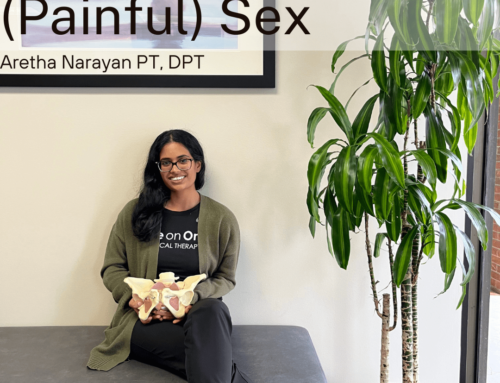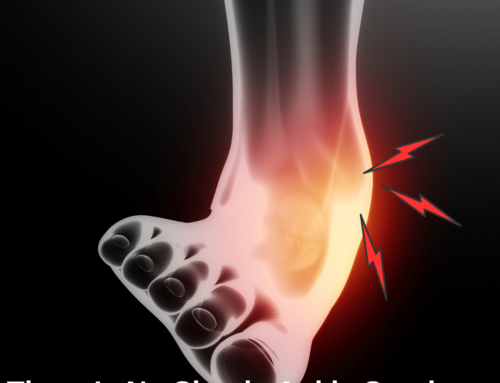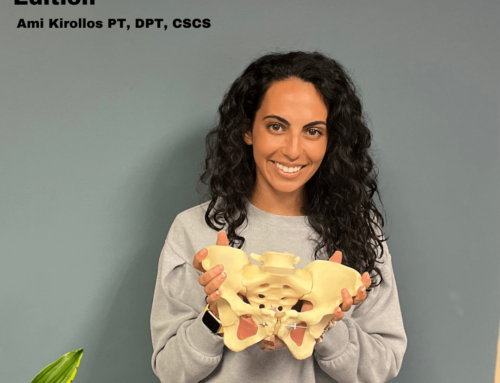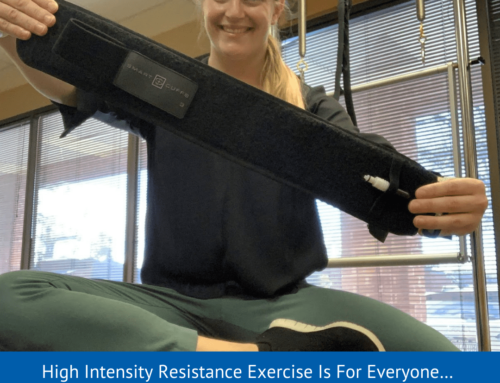ACL Injury In Sport
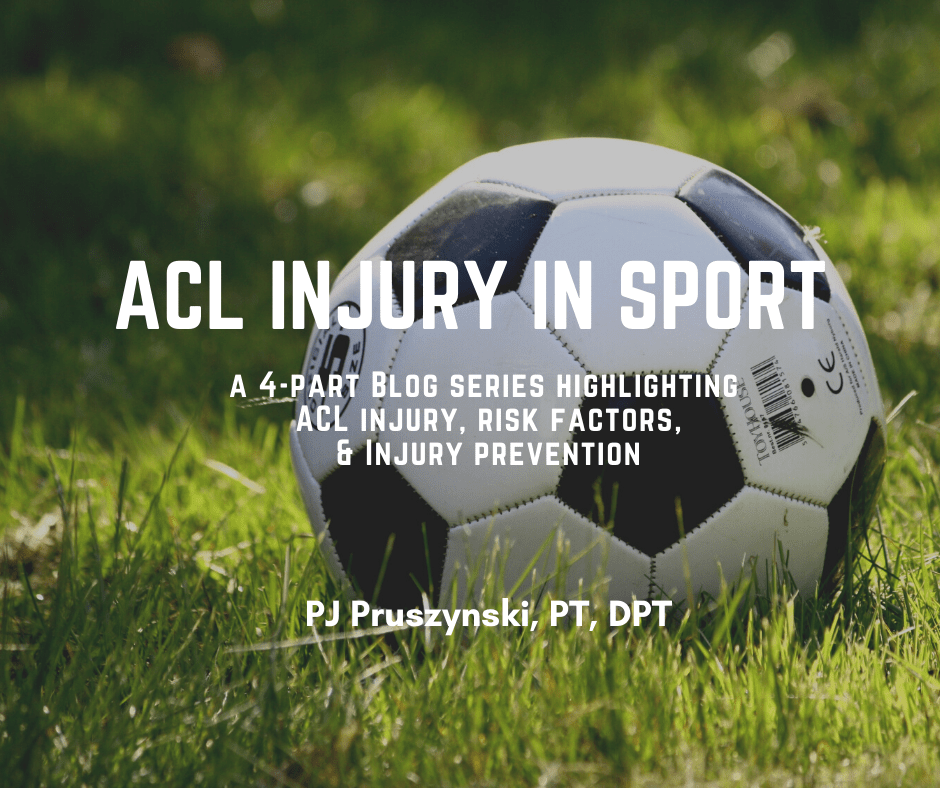
ACL injury occurs in about 200,000 people in the United States. Athletes between the ages of 6 and 18 years old are highly vulnerable to ACL injury. Just over half of the knee injuries in this age group are ACL tears. An athlete’s risk level varies depending on sport. A research study of high school athletes showed the highest risk sports for ACL injury was girl’s soccer, followed by football, girl’s basketball, and boy’s soccer. This high incidence of ACL tears takes a physical and emotional toll as well as a huge financial burden to the individual and health care system. It is estimated that $1 billion dollars is spent on ACL Reconstruction (ACL-R) surgery annually. Costs can incur from the emergency room or primary care physician’s office, the orthopedic surgeon, the imaging center, follow-up orthopedic surgeon visits, and physical therapy visits, which usually occur 3 times per week for 9-12 months.
What is the ACL?
The Anterior Cruciate Ligament, ACL, is a ligament that stabilizes the connection between your tibia (shin bone) and your femur (thigh bone). It prevents your shin bone from moving too far in front of your knee. It is incredibly important for providing stability to your entire knee joint especially for running, stair climbing, jumping, cutting, and pivoting.
Why is the ACL so Vulnerable to Injury?
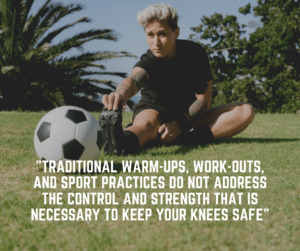
The knee is between two mobile joints, the ankle and hip.If your ankle or hip are not strong or stable, then undo stress can occur at your knee. Unfortunately, many traditional warm-ups, work-outs, and sport practices do not address the control and strength that is necessary to keep your knees safe. This is why 60% of ACL tears are considered a non-contact injury. That basically means that there was no hit or contact that caused this injury. In other words, it was PREVENTABLE.
What is the Recovery Time After ACL Reconstruction Surgery?
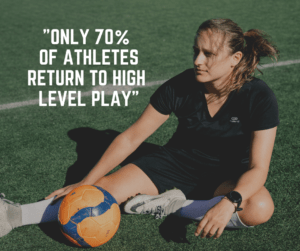
An ACL tear can sideline you from sports for 6-12 months or longer. Research suggests that it takes a year for elite athletes to return to play after ACL-R surgery and even after a lengthy rehabilitation, only 70% of athletes return to high level play.
Following an ACL tear or ACL-R surgery, an athlete is at an increased risk of future injury. The adolescents who have undergone ACL-R, 25% re-injured their ACL, either the same side or opposite side. Those who suffered an ACL tear are also at an increased risk of developing osteoarthritis as soon as 10 years following injury.
How Can We Prevent an ACL Injury?
In this 4 part blog series, we will:
- Discuss the factors that put athletes at increased risk of tearing their ACL.
- Highlight factors that can be changed like specific muscle weaknesses, myofascial weak links, and poor movement patterns.
- Explain how current injury prevention programs like Sportsmetrics, PEP, FIFA 11, and Harmoknee have attempted to address these changeable risk factors. A review of current research has determined the most effective prevention programs address flexibility, running, balance, strength, core stability, and plyometric motions. While these programs are a step in the right direction, we expand upon the shortcomings that have led One on One Physical Therapy to create a more comprehensive screening and prevention program to reduce risk of ACL tears.
- Describe what sets One on One Physical Therapy’s ACL prevention program apart. One on One PT’s ACL prevention program addresses the individual as well as the team, it focuses on sport specific motor patterns and recovery, which will reduce injury risk and optimize sport performance.
About the Author
 Dr. Patricia Pruszynski, DPT (who goes by P.J.) has a passion for working with people recovering from sports injuries, concussions and vestibular disorders. Dr. P.J. received her Doctorate in Physical Therapy from Emory University. She also studied alongside experts in the field at the world-renowned Duke University’s course for management of dizziness and balance disorders. Her advanced training in manual medicine and trigger point dry needling compliment her specialization in sports and vestibular rehabilitation allowing her to take “a whole-body approach”. Dr. P.J. graduated summa cum laude from the University of Delaware with a Bachelors in Exercise Science. She has a background in dance, track, and soccer. When P.J. is not working with patients, she enjoys traveling, hiking, and trying out new restaurants with her husband.
Dr. Patricia Pruszynski, DPT (who goes by P.J.) has a passion for working with people recovering from sports injuries, concussions and vestibular disorders. Dr. P.J. received her Doctorate in Physical Therapy from Emory University. She also studied alongside experts in the field at the world-renowned Duke University’s course for management of dizziness and balance disorders. Her advanced training in manual medicine and trigger point dry needling compliment her specialization in sports and vestibular rehabilitation allowing her to take “a whole-body approach”. Dr. P.J. graduated summa cum laude from the University of Delaware with a Bachelors in Exercise Science. She has a background in dance, track, and soccer. When P.J. is not working with patients, she enjoys traveling, hiking, and trying out new restaurants with her husband.
Sources
“A multisport Epidemiologic Comparison of Anterior Cruciate Ligament Injuries in High School Athletics” Joseph et. al.
“What are the Odds of Tearing Your ACL in the Sports You Play?” Theodore J. Ganley, MD
“International Epidemiology of Anterior Cruciate Ligament Injuries” Neeraj Singh.
“Mechanisms of the Anterior Cruciate Ligament Injury in Sports Activities: A Twenty-Year Clinical Research of 1,700 Athletes” by Kobayashi et al.
“Osteoarthritis and ACL reconstruction – Myths and Risk” Edward E Cheung et. al.
“Incidence of Contralateral or Ipsilateral Anterior Cruciate Ligament Injury After Primary ACL Reconstruction and Return to Sport” Paterno et. al.
“Mechanisms, Prediction, and prevention of ACL injuries: cut risk with 3 sharpened validated tools” Hewett et. al.
